Analysis of Collective and Social Learning Mechanisms in Industry
VerifiedAdded on 2022/11/27
|14
|4491
|186
Report
AI Summary
This report analyzes collective and social learning mechanisms within organizations, aiming to differentiate between social and collective learning and related constructs like group, co-operative, collaborative, and team learning. It explores various models of collective and social learning, including system and phase models, and discusses the development of these learning styles, providing workplace examples. The report also covers current social media, e-learning tools, and technologies, demonstrating how these tools contribute to organizational learning objectives and strategic agendas. Furthermore, it examines the 5Rs of social learning, the difference between descriptive scientific and perspective learning, and the commercial model of collective learning. Finally, the report offers a critical summary of factors to consider when implementing collective and social learning within an organization, covering aspects such as formal and informal learning approaches and their impact on fostering connections, building collaboration, and enhancing collective intelligence.
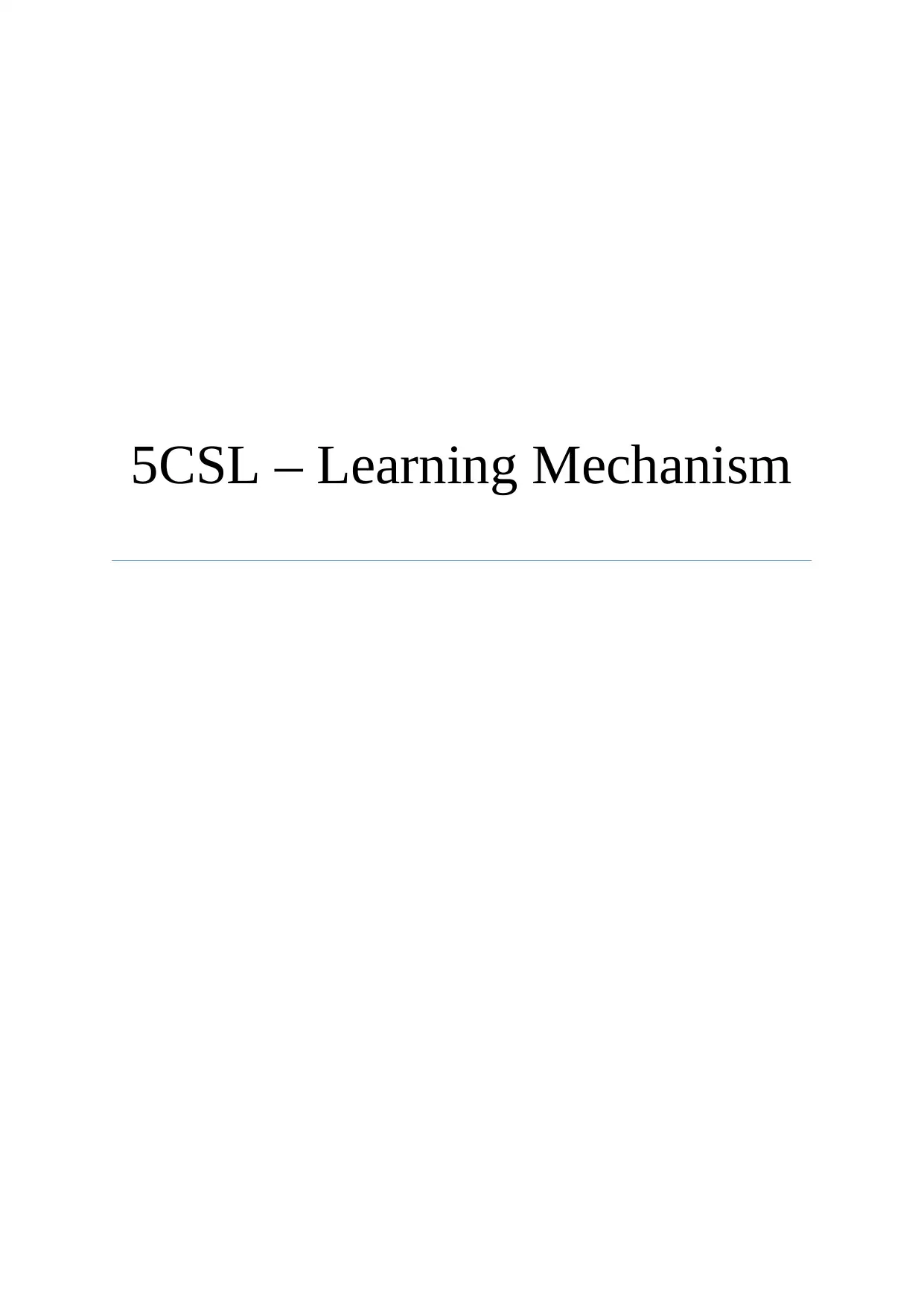
5CSL – Learning Mechanism
Paraphrase This Document
Need a fresh take? Get an instant paraphrase of this document with our AI Paraphraser
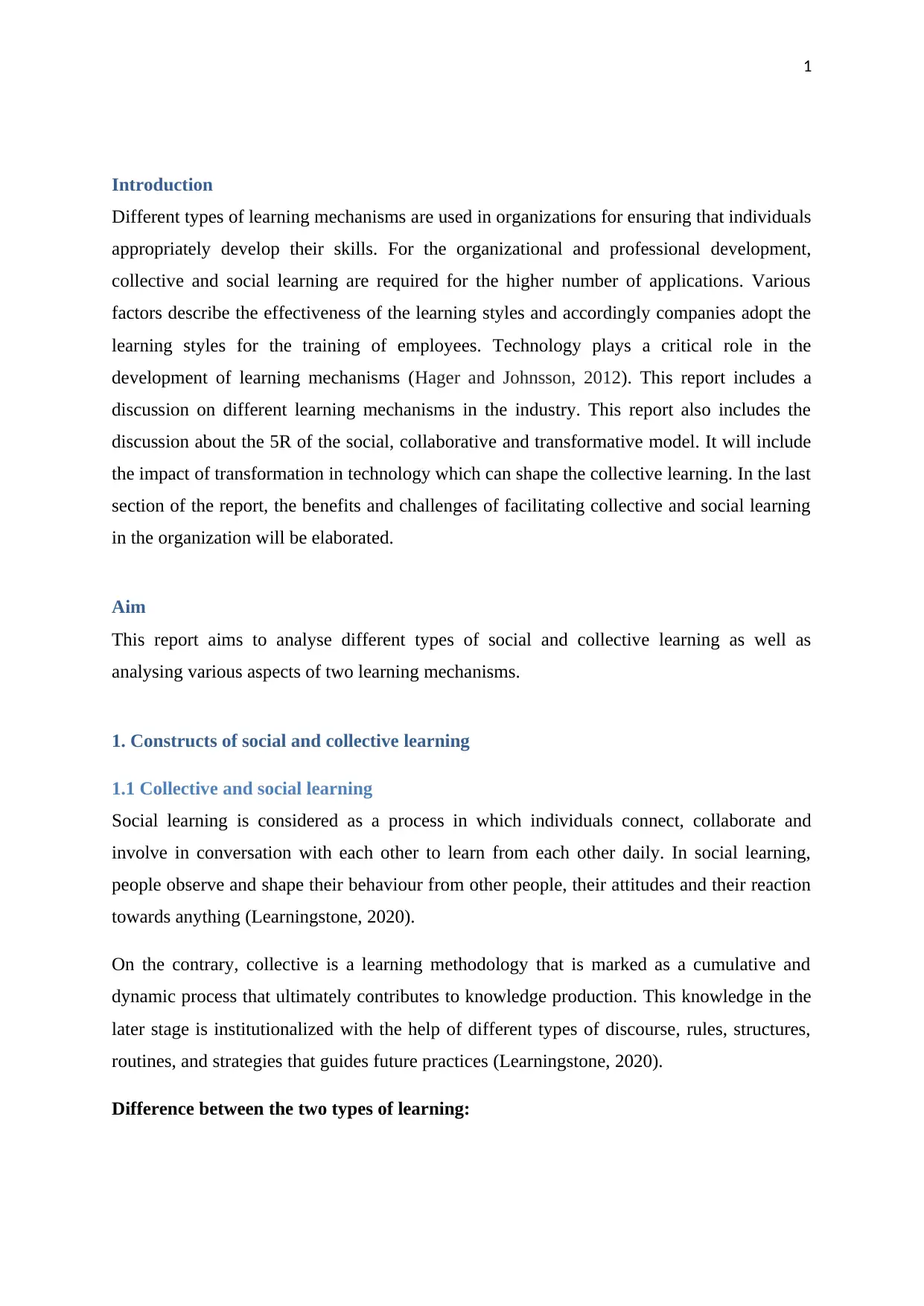
1
Introduction
Different types of learning mechanisms are used in organizations for ensuring that individuals
appropriately develop their skills. For the organizational and professional development,
collective and social learning are required for the higher number of applications. Various
factors describe the effectiveness of the learning styles and accordingly companies adopt the
learning styles for the training of employees. Technology plays a critical role in the
development of learning mechanisms (Hager and Johnsson, 2012). This report includes a
discussion on different learning mechanisms in the industry. This report also includes the
discussion about the 5R of the social, collaborative and transformative model. It will include
the impact of transformation in technology which can shape the collective learning. In the last
section of the report, the benefits and challenges of facilitating collective and social learning
in the organization will be elaborated.
Aim
This report aims to analyse different types of social and collective learning as well as
analysing various aspects of two learning mechanisms.
1. Constructs of social and collective learning
1.1 Collective and social learning
Social learning is considered as a process in which individuals connect, collaborate and
involve in conversation with each other to learn from each other daily. In social learning,
people observe and shape their behaviour from other people, their attitudes and their reaction
towards anything (Learningstone, 2020).
On the contrary, collective is a learning methodology that is marked as a cumulative and
dynamic process that ultimately contributes to knowledge production. This knowledge in the
later stage is institutionalized with the help of different types of discourse, rules, structures,
routines, and strategies that guides future practices (Learningstone, 2020).
Difference between the two types of learning:
Introduction
Different types of learning mechanisms are used in organizations for ensuring that individuals
appropriately develop their skills. For the organizational and professional development,
collective and social learning are required for the higher number of applications. Various
factors describe the effectiveness of the learning styles and accordingly companies adopt the
learning styles for the training of employees. Technology plays a critical role in the
development of learning mechanisms (Hager and Johnsson, 2012). This report includes a
discussion on different learning mechanisms in the industry. This report also includes the
discussion about the 5R of the social, collaborative and transformative model. It will include
the impact of transformation in technology which can shape the collective learning. In the last
section of the report, the benefits and challenges of facilitating collective and social learning
in the organization will be elaborated.
Aim
This report aims to analyse different types of social and collective learning as well as
analysing various aspects of two learning mechanisms.
1. Constructs of social and collective learning
1.1 Collective and social learning
Social learning is considered as a process in which individuals connect, collaborate and
involve in conversation with each other to learn from each other daily. In social learning,
people observe and shape their behaviour from other people, their attitudes and their reaction
towards anything (Learningstone, 2020).
On the contrary, collective is a learning methodology that is marked as a cumulative and
dynamic process that ultimately contributes to knowledge production. This knowledge in the
later stage is institutionalized with the help of different types of discourse, rules, structures,
routines, and strategies that guides future practices (Learningstone, 2020).
Difference between the two types of learning:
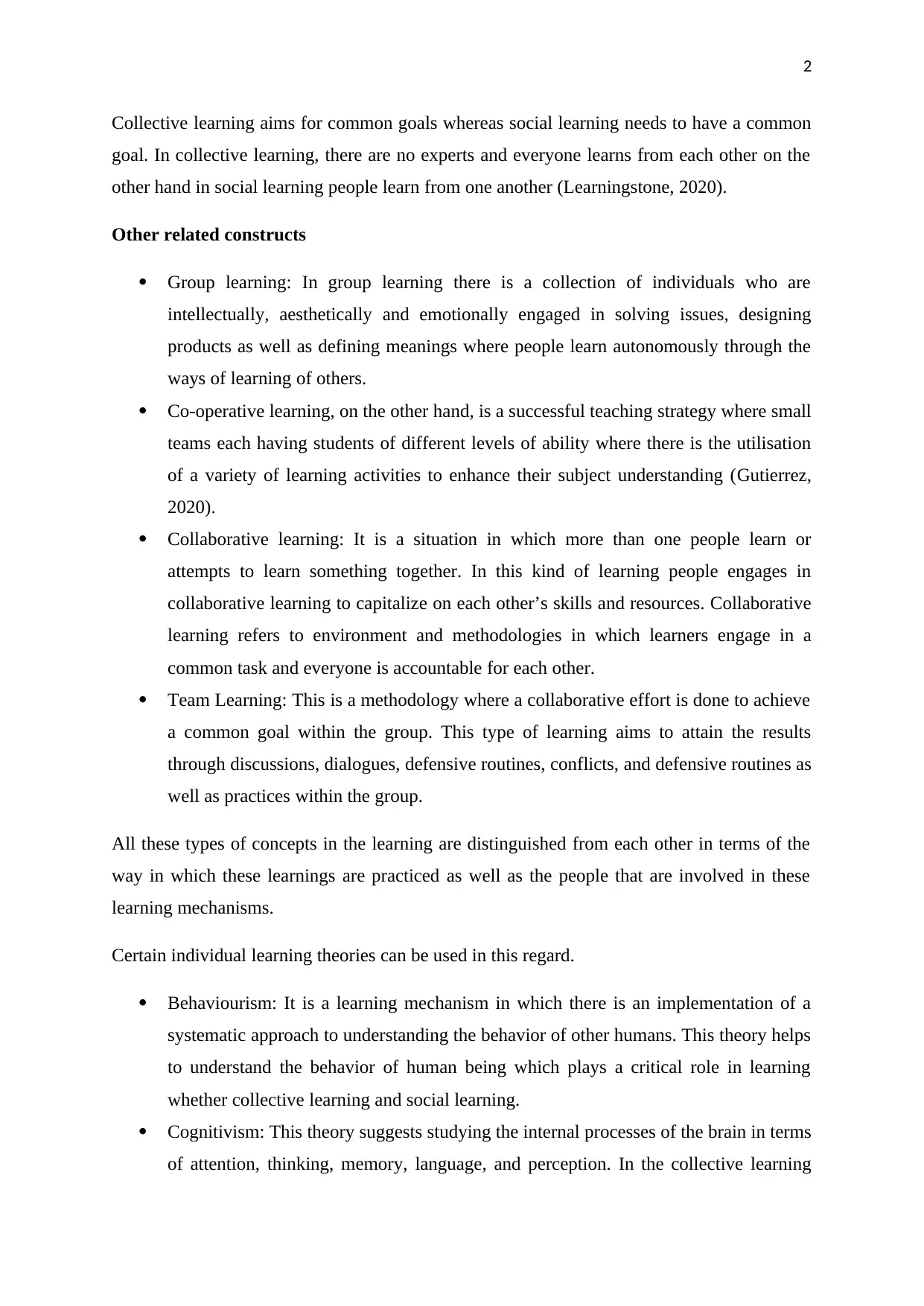
2
Collective learning aims for common goals whereas social learning needs to have a common
goal. In collective learning, there are no experts and everyone learns from each other on the
other hand in social learning people learn from one another (Learningstone, 2020).
Other related constructs
Group learning: In group learning there is a collection of individuals who are
intellectually, aesthetically and emotionally engaged in solving issues, designing
products as well as defining meanings where people learn autonomously through the
ways of learning of others.
Co-operative learning, on the other hand, is a successful teaching strategy where small
teams each having students of different levels of ability where there is the utilisation
of a variety of learning activities to enhance their subject understanding (Gutierrez,
2020).
Collaborative learning: It is a situation in which more than one people learn or
attempts to learn something together. In this kind of learning people engages in
collaborative learning to capitalize on each other’s skills and resources. Collaborative
learning refers to environment and methodologies in which learners engage in a
common task and everyone is accountable for each other.
Team Learning: This is a methodology where a collaborative effort is done to achieve
a common goal within the group. This type of learning aims to attain the results
through discussions, dialogues, defensive routines, conflicts, and defensive routines as
well as practices within the group.
All these types of concepts in the learning are distinguished from each other in terms of the
way in which these learnings are practiced as well as the people that are involved in these
learning mechanisms.
Certain individual learning theories can be used in this regard.
Behaviourism: It is a learning mechanism in which there is an implementation of a
systematic approach to understanding the behavior of other humans. This theory helps
to understand the behavior of human being which plays a critical role in learning
whether collective learning and social learning.
Cognitivism: This theory suggests studying the internal processes of the brain in terms
of attention, thinking, memory, language, and perception. In the collective learning
Collective learning aims for common goals whereas social learning needs to have a common
goal. In collective learning, there are no experts and everyone learns from each other on the
other hand in social learning people learn from one another (Learningstone, 2020).
Other related constructs
Group learning: In group learning there is a collection of individuals who are
intellectually, aesthetically and emotionally engaged in solving issues, designing
products as well as defining meanings where people learn autonomously through the
ways of learning of others.
Co-operative learning, on the other hand, is a successful teaching strategy where small
teams each having students of different levels of ability where there is the utilisation
of a variety of learning activities to enhance their subject understanding (Gutierrez,
2020).
Collaborative learning: It is a situation in which more than one people learn or
attempts to learn something together. In this kind of learning people engages in
collaborative learning to capitalize on each other’s skills and resources. Collaborative
learning refers to environment and methodologies in which learners engage in a
common task and everyone is accountable for each other.
Team Learning: This is a methodology where a collaborative effort is done to achieve
a common goal within the group. This type of learning aims to attain the results
through discussions, dialogues, defensive routines, conflicts, and defensive routines as
well as practices within the group.
All these types of concepts in the learning are distinguished from each other in terms of the
way in which these learnings are practiced as well as the people that are involved in these
learning mechanisms.
Certain individual learning theories can be used in this regard.
Behaviourism: It is a learning mechanism in which there is an implementation of a
systematic approach to understanding the behavior of other humans. This theory helps
to understand the behavior of human being which plays a critical role in learning
whether collective learning and social learning.
Cognitivism: This theory suggests studying the internal processes of the brain in terms
of attention, thinking, memory, language, and perception. In the collective learning
⊘ This is a preview!⊘
Do you want full access?
Subscribe today to unlock all pages.

Trusted by 1+ million students worldwide
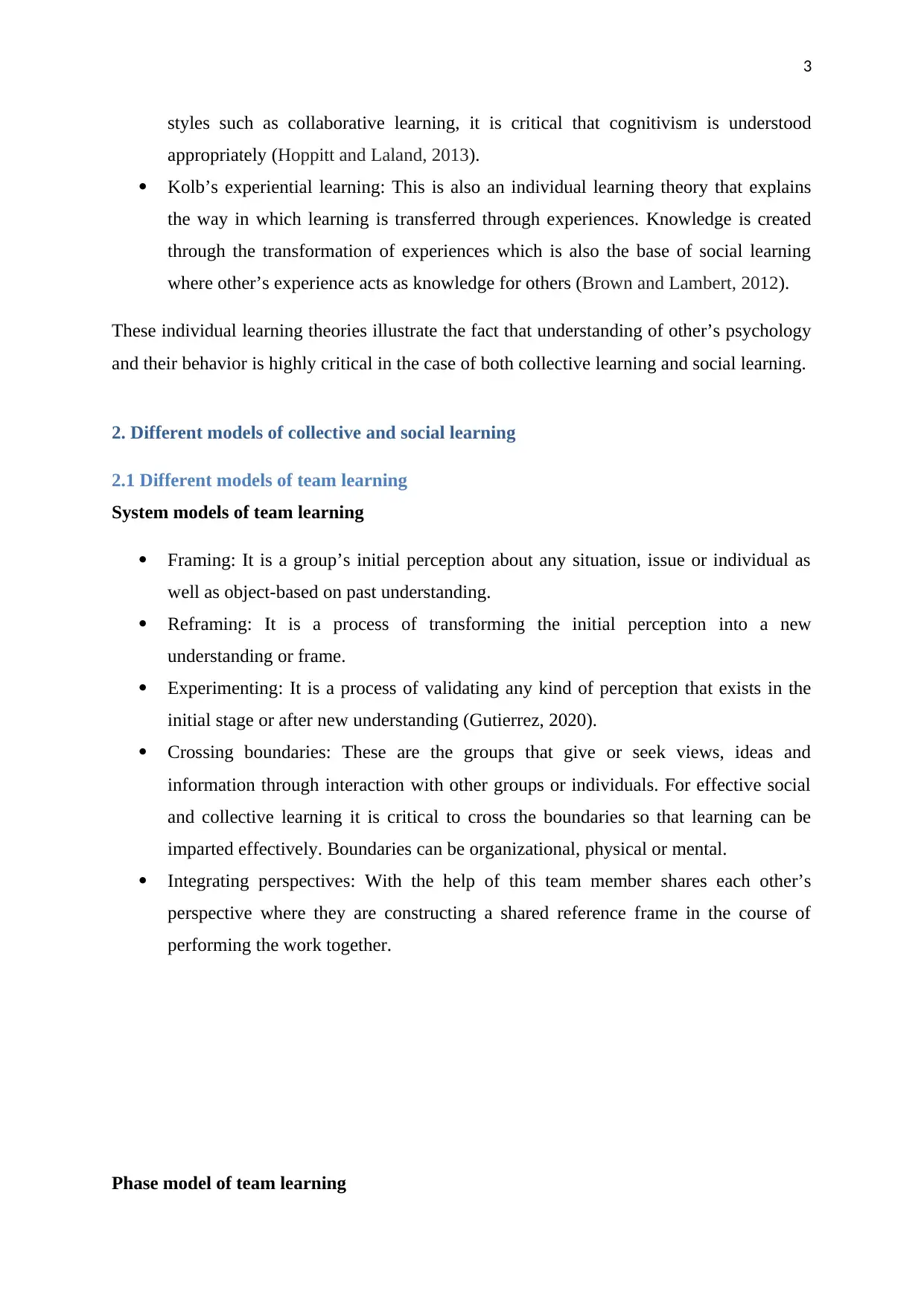
3
styles such as collaborative learning, it is critical that cognitivism is understood
appropriately (Hoppitt and Laland, 2013).
Kolb’s experiential learning: This is also an individual learning theory that explains
the way in which learning is transferred through experiences. Knowledge is created
through the transformation of experiences which is also the base of social learning
where other’s experience acts as knowledge for others (Brown and Lambert, 2012).
These individual learning theories illustrate the fact that understanding of other’s psychology
and their behavior is highly critical in the case of both collective learning and social learning.
2. Different models of collective and social learning
2.1 Different models of team learning
System models of team learning
Framing: It is a group’s initial perception about any situation, issue or individual as
well as object-based on past understanding.
Reframing: It is a process of transforming the initial perception into a new
understanding or frame.
Experimenting: It is a process of validating any kind of perception that exists in the
initial stage or after new understanding (Gutierrez, 2020).
Crossing boundaries: These are the groups that give or seek views, ideas and
information through interaction with other groups or individuals. For effective social
and collective learning it is critical to cross the boundaries so that learning can be
imparted effectively. Boundaries can be organizational, physical or mental.
Integrating perspectives: With the help of this team member shares each other’s
perspective where they are constructing a shared reference frame in the course of
performing the work together.
Phase model of team learning
styles such as collaborative learning, it is critical that cognitivism is understood
appropriately (Hoppitt and Laland, 2013).
Kolb’s experiential learning: This is also an individual learning theory that explains
the way in which learning is transferred through experiences. Knowledge is created
through the transformation of experiences which is also the base of social learning
where other’s experience acts as knowledge for others (Brown and Lambert, 2012).
These individual learning theories illustrate the fact that understanding of other’s psychology
and their behavior is highly critical in the case of both collective learning and social learning.
2. Different models of collective and social learning
2.1 Different models of team learning
System models of team learning
Framing: It is a group’s initial perception about any situation, issue or individual as
well as object-based on past understanding.
Reframing: It is a process of transforming the initial perception into a new
understanding or frame.
Experimenting: It is a process of validating any kind of perception that exists in the
initial stage or after new understanding (Gutierrez, 2020).
Crossing boundaries: These are the groups that give or seek views, ideas and
information through interaction with other groups or individuals. For effective social
and collective learning it is critical to cross the boundaries so that learning can be
imparted effectively. Boundaries can be organizational, physical or mental.
Integrating perspectives: With the help of this team member shares each other’s
perspective where they are constructing a shared reference frame in the course of
performing the work together.
Phase model of team learning
Paraphrase This Document
Need a fresh take? Get an instant paraphrase of this document with our AI Paraphraser
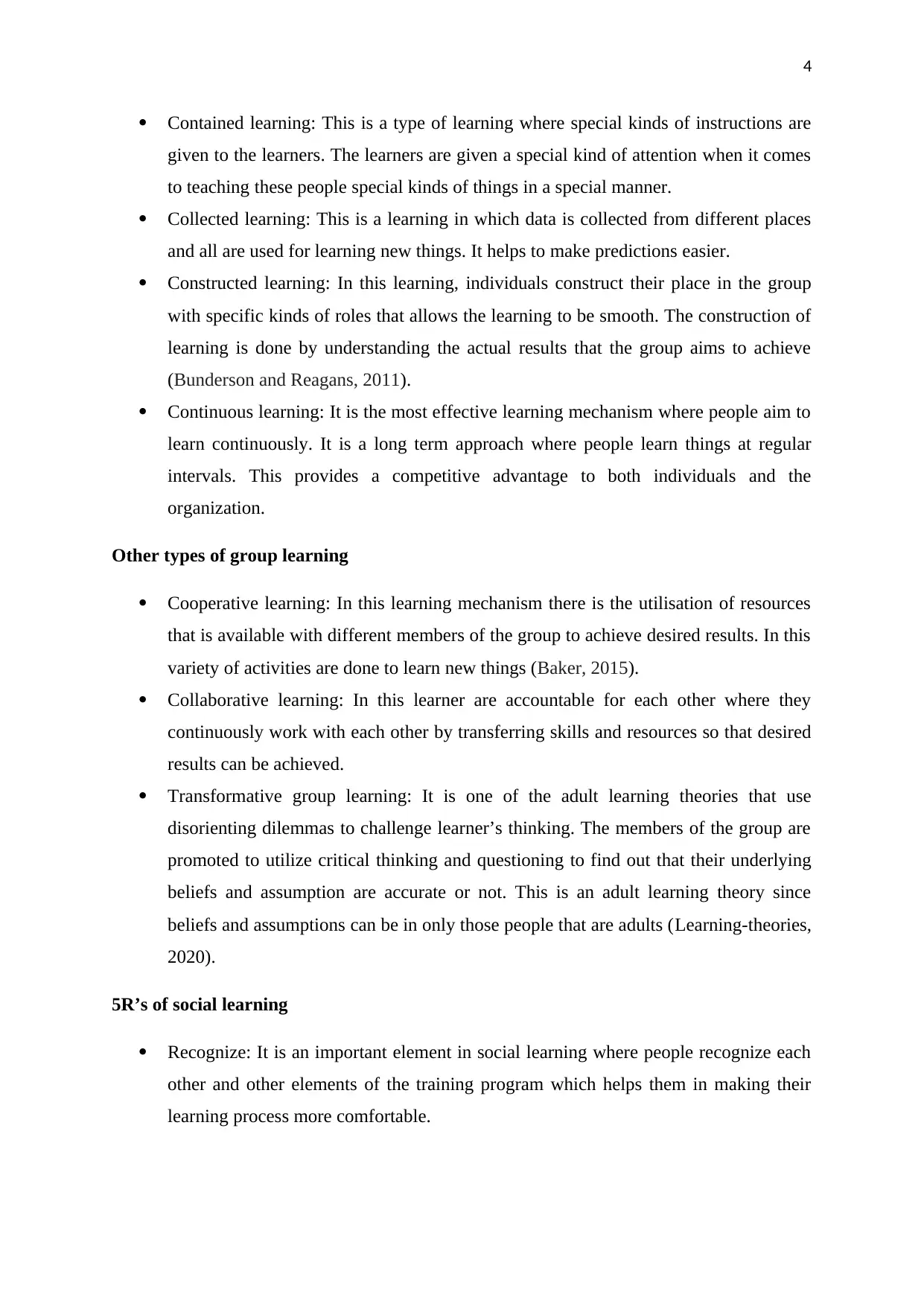
4
Contained learning: This is a type of learning where special kinds of instructions are
given to the learners. The learners are given a special kind of attention when it comes
to teaching these people special kinds of things in a special manner.
Collected learning: This is a learning in which data is collected from different places
and all are used for learning new things. It helps to make predictions easier.
Constructed learning: In this learning, individuals construct their place in the group
with specific kinds of roles that allows the learning to be smooth. The construction of
learning is done by understanding the actual results that the group aims to achieve
(Bunderson and Reagans, 2011).
Continuous learning: It is the most effective learning mechanism where people aim to
learn continuously. It is a long term approach where people learn things at regular
intervals. This provides a competitive advantage to both individuals and the
organization.
Other types of group learning
Cooperative learning: In this learning mechanism there is the utilisation of resources
that is available with different members of the group to achieve desired results. In this
variety of activities are done to learn new things (Baker, 2015).
Collaborative learning: In this learner are accountable for each other where they
continuously work with each other by transferring skills and resources so that desired
results can be achieved.
Transformative group learning: It is one of the adult learning theories that use
disorienting dilemmas to challenge learner’s thinking. The members of the group are
promoted to utilize critical thinking and questioning to find out that their underlying
beliefs and assumption are accurate or not. This is an adult learning theory since
beliefs and assumptions can be in only those people that are adults (Learning-theories,
2020).
5R’s of social learning
Recognize: It is an important element in social learning where people recognize each
other and other elements of the training program which helps them in making their
learning process more comfortable.
Contained learning: This is a type of learning where special kinds of instructions are
given to the learners. The learners are given a special kind of attention when it comes
to teaching these people special kinds of things in a special manner.
Collected learning: This is a learning in which data is collected from different places
and all are used for learning new things. It helps to make predictions easier.
Constructed learning: In this learning, individuals construct their place in the group
with specific kinds of roles that allows the learning to be smooth. The construction of
learning is done by understanding the actual results that the group aims to achieve
(Bunderson and Reagans, 2011).
Continuous learning: It is the most effective learning mechanism where people aim to
learn continuously. It is a long term approach where people learn things at regular
intervals. This provides a competitive advantage to both individuals and the
organization.
Other types of group learning
Cooperative learning: In this learning mechanism there is the utilisation of resources
that is available with different members of the group to achieve desired results. In this
variety of activities are done to learn new things (Baker, 2015).
Collaborative learning: In this learner are accountable for each other where they
continuously work with each other by transferring skills and resources so that desired
results can be achieved.
Transformative group learning: It is one of the adult learning theories that use
disorienting dilemmas to challenge learner’s thinking. The members of the group are
promoted to utilize critical thinking and questioning to find out that their underlying
beliefs and assumption are accurate or not. This is an adult learning theory since
beliefs and assumptions can be in only those people that are adults (Learning-theories,
2020).
5R’s of social learning
Recognize: It is an important element in social learning where people recognize each
other and other elements of the training program which helps them in making their
learning process more comfortable.
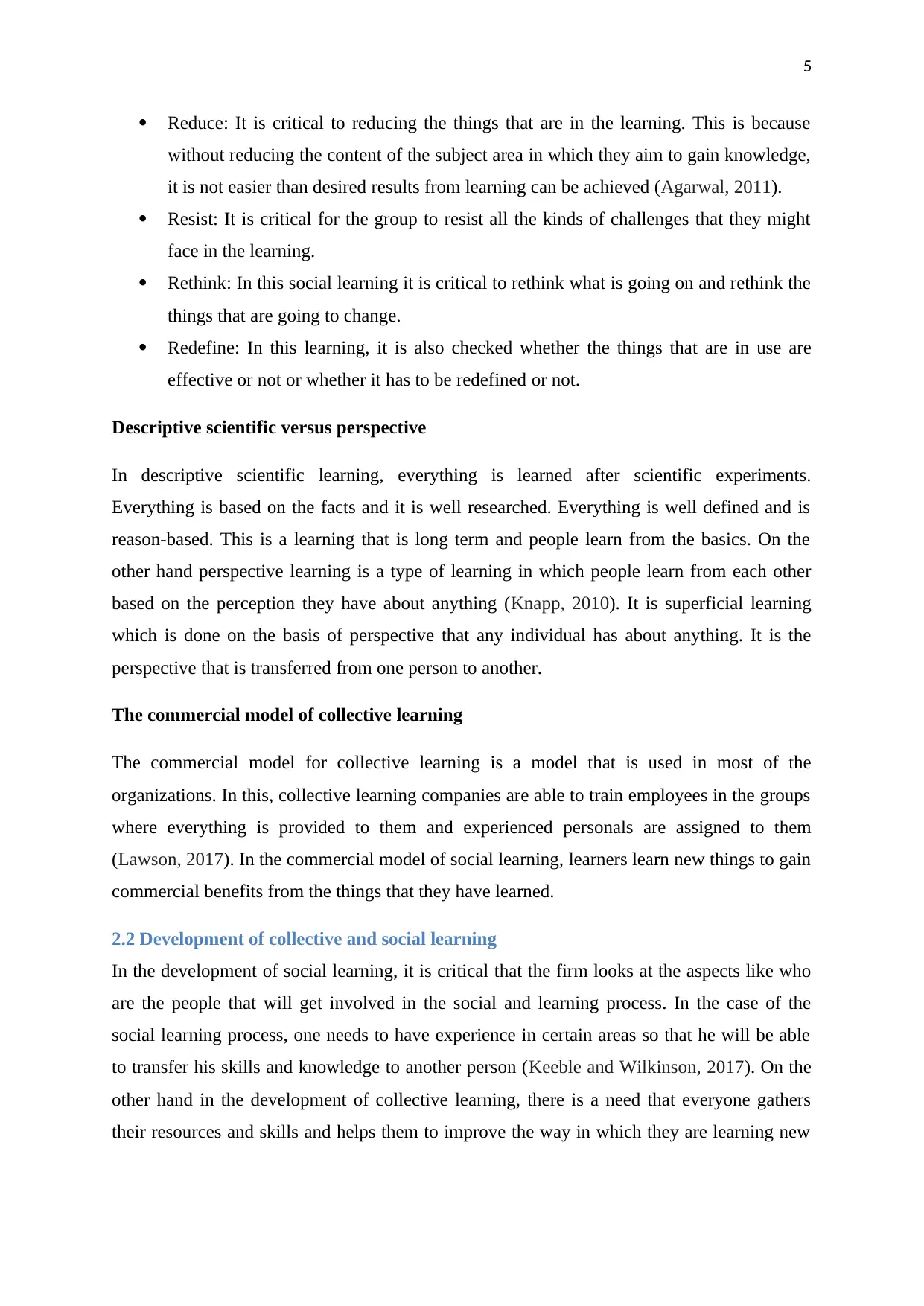
5
Reduce: It is critical to reducing the things that are in the learning. This is because
without reducing the content of the subject area in which they aim to gain knowledge,
it is not easier than desired results from learning can be achieved (Agarwal, 2011).
Resist: It is critical for the group to resist all the kinds of challenges that they might
face in the learning.
Rethink: In this social learning it is critical to rethink what is going on and rethink the
things that are going to change.
Redefine: In this learning, it is also checked whether the things that are in use are
effective or not or whether it has to be redefined or not.
Descriptive scientific versus perspective
In descriptive scientific learning, everything is learned after scientific experiments.
Everything is based on the facts and it is well researched. Everything is well defined and is
reason-based. This is a learning that is long term and people learn from the basics. On the
other hand perspective learning is a type of learning in which people learn from each other
based on the perception they have about anything (Knapp, 2010). It is superficial learning
which is done on the basis of perspective that any individual has about anything. It is the
perspective that is transferred from one person to another.
The commercial model of collective learning
The commercial model for collective learning is a model that is used in most of the
organizations. In this, collective learning companies are able to train employees in the groups
where everything is provided to them and experienced personals are assigned to them
(Lawson, 2017). In the commercial model of social learning, learners learn new things to gain
commercial benefits from the things that they have learned.
2.2 Development of collective and social learning
In the development of social learning, it is critical that the firm looks at the aspects like who
are the people that will get involved in the social and learning process. In the case of the
social learning process, one needs to have experience in certain areas so that he will be able
to transfer his skills and knowledge to another person (Keeble and Wilkinson, 2017). On the
other hand in the development of collective learning, there is a need that everyone gathers
their resources and skills and helps them to improve the way in which they are learning new
Reduce: It is critical to reducing the things that are in the learning. This is because
without reducing the content of the subject area in which they aim to gain knowledge,
it is not easier than desired results from learning can be achieved (Agarwal, 2011).
Resist: It is critical for the group to resist all the kinds of challenges that they might
face in the learning.
Rethink: In this social learning it is critical to rethink what is going on and rethink the
things that are going to change.
Redefine: In this learning, it is also checked whether the things that are in use are
effective or not or whether it has to be redefined or not.
Descriptive scientific versus perspective
In descriptive scientific learning, everything is learned after scientific experiments.
Everything is based on the facts and it is well researched. Everything is well defined and is
reason-based. This is a learning that is long term and people learn from the basics. On the
other hand perspective learning is a type of learning in which people learn from each other
based on the perception they have about anything (Knapp, 2010). It is superficial learning
which is done on the basis of perspective that any individual has about anything. It is the
perspective that is transferred from one person to another.
The commercial model of collective learning
The commercial model for collective learning is a model that is used in most of the
organizations. In this, collective learning companies are able to train employees in the groups
where everything is provided to them and experienced personals are assigned to them
(Lawson, 2017). In the commercial model of social learning, learners learn new things to gain
commercial benefits from the things that they have learned.
2.2 Development of collective and social learning
In the development of social learning, it is critical that the firm looks at the aspects like who
are the people that will get involved in the social and learning process. In the case of the
social learning process, one needs to have experience in certain areas so that he will be able
to transfer his skills and knowledge to another person (Keeble and Wilkinson, 2017). On the
other hand in the development of collective learning, there is a need that everyone gathers
their resources and skills and helps them to improve the way in which they are learning new
⊘ This is a preview!⊘
Do you want full access?
Subscribe today to unlock all pages.

Trusted by 1+ million students worldwide
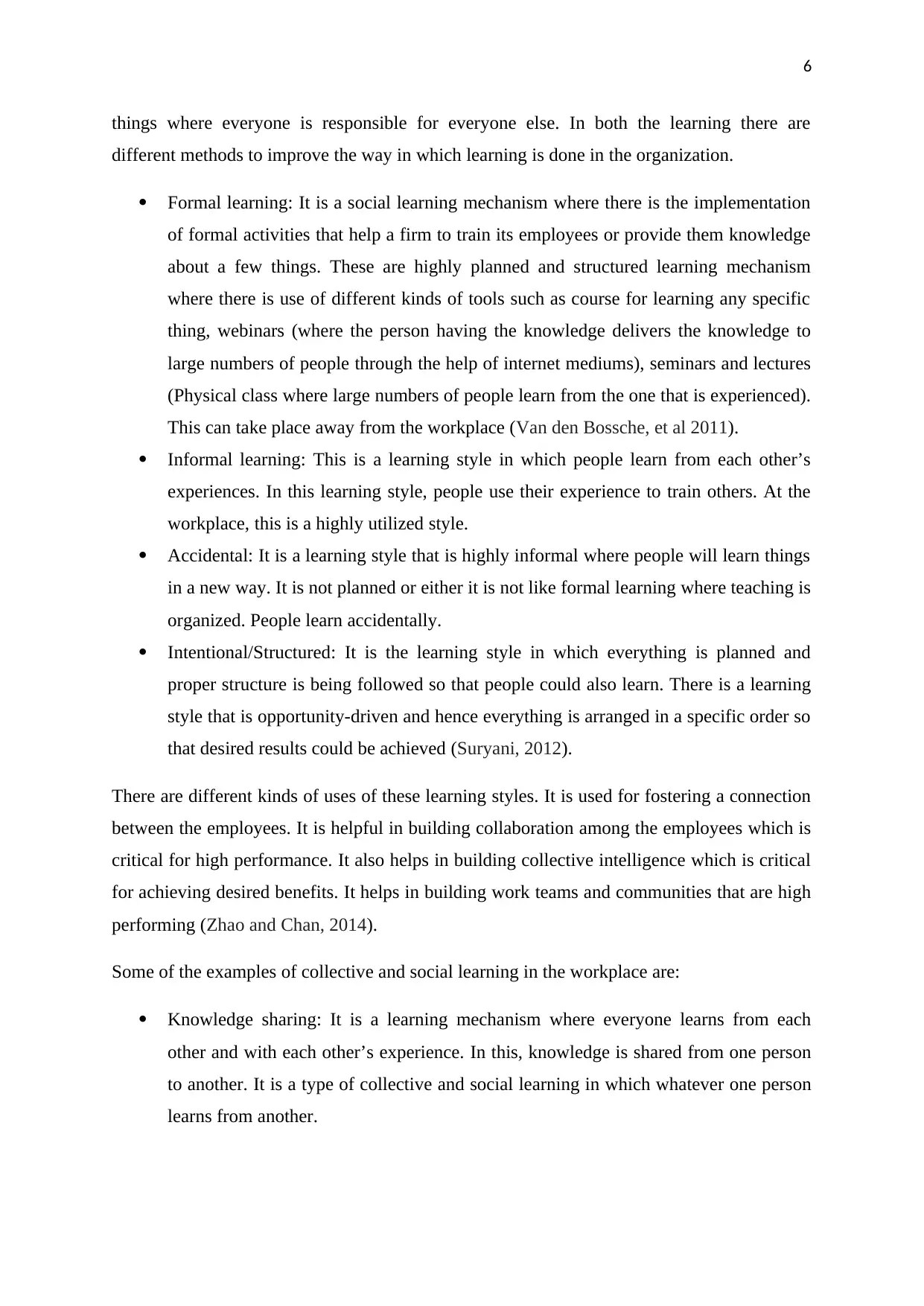
6
things where everyone is responsible for everyone else. In both the learning there are
different methods to improve the way in which learning is done in the organization.
Formal learning: It is a social learning mechanism where there is the implementation
of formal activities that help a firm to train its employees or provide them knowledge
about a few things. These are highly planned and structured learning mechanism
where there is use of different kinds of tools such as course for learning any specific
thing, webinars (where the person having the knowledge delivers the knowledge to
large numbers of people through the help of internet mediums), seminars and lectures
(Physical class where large numbers of people learn from the one that is experienced).
This can take place away from the workplace (Van den Bossche, et al 2011).
Informal learning: This is a learning style in which people learn from each other’s
experiences. In this learning style, people use their experience to train others. At the
workplace, this is a highly utilized style.
Accidental: It is a learning style that is highly informal where people will learn things
in a new way. It is not planned or either it is not like formal learning where teaching is
organized. People learn accidentally.
Intentional/Structured: It is the learning style in which everything is planned and
proper structure is being followed so that people could also learn. There is a learning
style that is opportunity-driven and hence everything is arranged in a specific order so
that desired results could be achieved (Suryani, 2012).
There are different kinds of uses of these learning styles. It is used for fostering a connection
between the employees. It is helpful in building collaboration among the employees which is
critical for high performance. It also helps in building collective intelligence which is critical
for achieving desired benefits. It helps in building work teams and communities that are high
performing (Zhao and Chan, 2014).
Some of the examples of collective and social learning in the workplace are:
Knowledge sharing: It is a learning mechanism where everyone learns from each
other and with each other’s experience. In this, knowledge is shared from one person
to another. It is a type of collective and social learning in which whatever one person
learns from another.
things where everyone is responsible for everyone else. In both the learning there are
different methods to improve the way in which learning is done in the organization.
Formal learning: It is a social learning mechanism where there is the implementation
of formal activities that help a firm to train its employees or provide them knowledge
about a few things. These are highly planned and structured learning mechanism
where there is use of different kinds of tools such as course for learning any specific
thing, webinars (where the person having the knowledge delivers the knowledge to
large numbers of people through the help of internet mediums), seminars and lectures
(Physical class where large numbers of people learn from the one that is experienced).
This can take place away from the workplace (Van den Bossche, et al 2011).
Informal learning: This is a learning style in which people learn from each other’s
experiences. In this learning style, people use their experience to train others. At the
workplace, this is a highly utilized style.
Accidental: It is a learning style that is highly informal where people will learn things
in a new way. It is not planned or either it is not like formal learning where teaching is
organized. People learn accidentally.
Intentional/Structured: It is the learning style in which everything is planned and
proper structure is being followed so that people could also learn. There is a learning
style that is opportunity-driven and hence everything is arranged in a specific order so
that desired results could be achieved (Suryani, 2012).
There are different kinds of uses of these learning styles. It is used for fostering a connection
between the employees. It is helpful in building collaboration among the employees which is
critical for high performance. It also helps in building collective intelligence which is critical
for achieving desired benefits. It helps in building work teams and communities that are high
performing (Zhao and Chan, 2014).
Some of the examples of collective and social learning in the workplace are:
Knowledge sharing: It is a learning mechanism where everyone learns from each
other and with each other’s experience. In this, knowledge is shared from one person
to another. It is a type of collective and social learning in which whatever one person
learns from another.
Paraphrase This Document
Need a fresh take? Get an instant paraphrase of this document with our AI Paraphraser
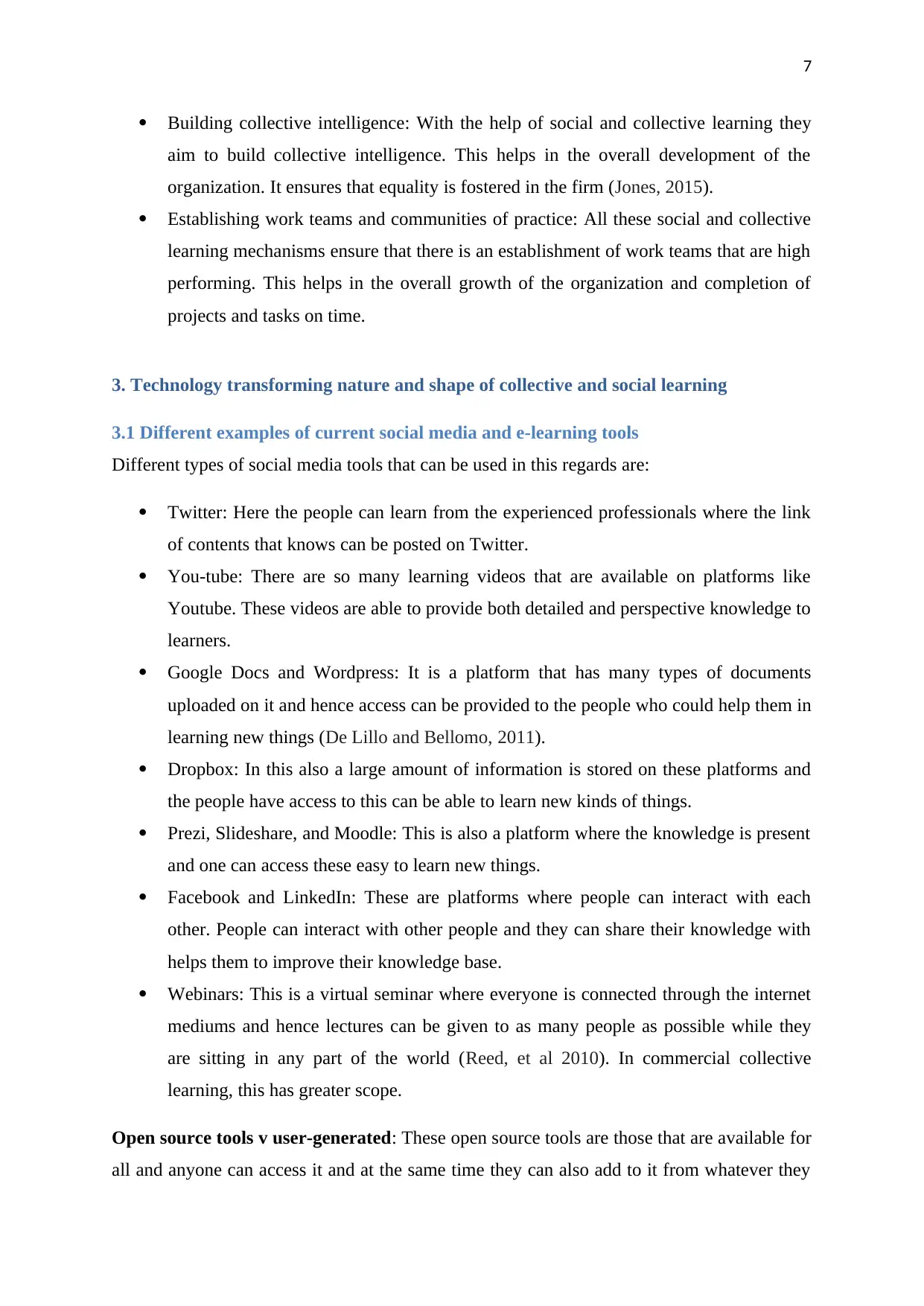
7
Building collective intelligence: With the help of social and collective learning they
aim to build collective intelligence. This helps in the overall development of the
organization. It ensures that equality is fostered in the firm (Jones, 2015).
Establishing work teams and communities of practice: All these social and collective
learning mechanisms ensure that there is an establishment of work teams that are high
performing. This helps in the overall growth of the organization and completion of
projects and tasks on time.
3. Technology transforming nature and shape of collective and social learning
3.1 Different examples of current social media and e-learning tools
Different types of social media tools that can be used in this regards are:
Twitter: Here the people can learn from the experienced professionals where the link
of contents that knows can be posted on Twitter.
You-tube: There are so many learning videos that are available on platforms like
Youtube. These videos are able to provide both detailed and perspective knowledge to
learners.
Google Docs and Wordpress: It is a platform that has many types of documents
uploaded on it and hence access can be provided to the people who could help them in
learning new things (De Lillo and Bellomo, 2011).
Dropbox: In this also a large amount of information is stored on these platforms and
the people have access to this can be able to learn new kinds of things.
Prezi, Slideshare, and Moodle: This is also a platform where the knowledge is present
and one can access these easy to learn new things.
Facebook and LinkedIn: These are platforms where people can interact with each
other. People can interact with other people and they can share their knowledge with
helps them to improve their knowledge base.
Webinars: This is a virtual seminar where everyone is connected through the internet
mediums and hence lectures can be given to as many people as possible while they
are sitting in any part of the world (Reed, et al 2010). In commercial collective
learning, this has greater scope.
Open source tools v user-generated: These open source tools are those that are available for
all and anyone can access it and at the same time they can also add to it from whatever they
Building collective intelligence: With the help of social and collective learning they
aim to build collective intelligence. This helps in the overall development of the
organization. It ensures that equality is fostered in the firm (Jones, 2015).
Establishing work teams and communities of practice: All these social and collective
learning mechanisms ensure that there is an establishment of work teams that are high
performing. This helps in the overall growth of the organization and completion of
projects and tasks on time.
3. Technology transforming nature and shape of collective and social learning
3.1 Different examples of current social media and e-learning tools
Different types of social media tools that can be used in this regards are:
Twitter: Here the people can learn from the experienced professionals where the link
of contents that knows can be posted on Twitter.
You-tube: There are so many learning videos that are available on platforms like
Youtube. These videos are able to provide both detailed and perspective knowledge to
learners.
Google Docs and Wordpress: It is a platform that has many types of documents
uploaded on it and hence access can be provided to the people who could help them in
learning new things (De Lillo and Bellomo, 2011).
Dropbox: In this also a large amount of information is stored on these platforms and
the people have access to this can be able to learn new kinds of things.
Prezi, Slideshare, and Moodle: This is also a platform where the knowledge is present
and one can access these easy to learn new things.
Facebook and LinkedIn: These are platforms where people can interact with each
other. People can interact with other people and they can share their knowledge with
helps them to improve their knowledge base.
Webinars: This is a virtual seminar where everyone is connected through the internet
mediums and hence lectures can be given to as many people as possible while they
are sitting in any part of the world (Reed, et al 2010). In commercial collective
learning, this has greater scope.
Open source tools v user-generated: These open source tools are those that are available for
all and anyone can access it and at the same time they can also add to it from whatever they
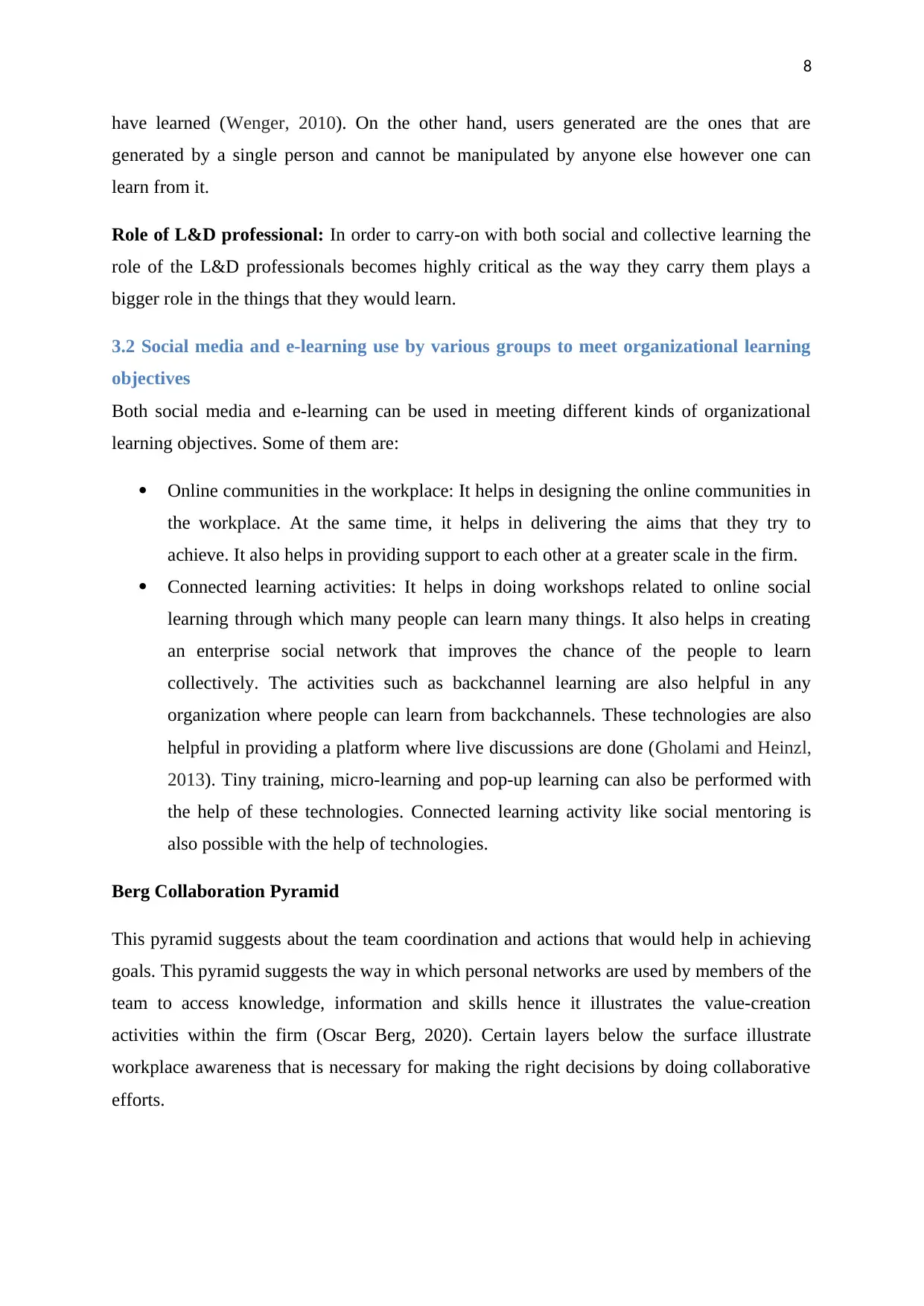
8
have learned (Wenger, 2010). On the other hand, users generated are the ones that are
generated by a single person and cannot be manipulated by anyone else however one can
learn from it.
Role of L&D professional: In order to carry-on with both social and collective learning the
role of the L&D professionals becomes highly critical as the way they carry them plays a
bigger role in the things that they would learn.
3.2 Social media and e-learning use by various groups to meet organizational learning
objectives
Both social media and e-learning can be used in meeting different kinds of organizational
learning objectives. Some of them are:
Online communities in the workplace: It helps in designing the online communities in
the workplace. At the same time, it helps in delivering the aims that they try to
achieve. It also helps in providing support to each other at a greater scale in the firm.
Connected learning activities: It helps in doing workshops related to online social
learning through which many people can learn many things. It also helps in creating
an enterprise social network that improves the chance of the people to learn
collectively. The activities such as backchannel learning are also helpful in any
organization where people can learn from backchannels. These technologies are also
helpful in providing a platform where live discussions are done (Gholami and Heinzl,
2013). Tiny training, micro-learning and pop-up learning can also be performed with
the help of these technologies. Connected learning activity like social mentoring is
also possible with the help of technologies.
Berg Collaboration Pyramid
This pyramid suggests about the team coordination and actions that would help in achieving
goals. This pyramid suggests the way in which personal networks are used by members of the
team to access knowledge, information and skills hence it illustrates the value-creation
activities within the firm (Oscar Berg, 2020). Certain layers below the surface illustrate
workplace awareness that is necessary for making the right decisions by doing collaborative
efforts.
have learned (Wenger, 2010). On the other hand, users generated are the ones that are
generated by a single person and cannot be manipulated by anyone else however one can
learn from it.
Role of L&D professional: In order to carry-on with both social and collective learning the
role of the L&D professionals becomes highly critical as the way they carry them plays a
bigger role in the things that they would learn.
3.2 Social media and e-learning use by various groups to meet organizational learning
objectives
Both social media and e-learning can be used in meeting different kinds of organizational
learning objectives. Some of them are:
Online communities in the workplace: It helps in designing the online communities in
the workplace. At the same time, it helps in delivering the aims that they try to
achieve. It also helps in providing support to each other at a greater scale in the firm.
Connected learning activities: It helps in doing workshops related to online social
learning through which many people can learn many things. It also helps in creating
an enterprise social network that improves the chance of the people to learn
collectively. The activities such as backchannel learning are also helpful in any
organization where people can learn from backchannels. These technologies are also
helpful in providing a platform where live discussions are done (Gholami and Heinzl,
2013). Tiny training, micro-learning and pop-up learning can also be performed with
the help of these technologies. Connected learning activity like social mentoring is
also possible with the help of technologies.
Berg Collaboration Pyramid
This pyramid suggests about the team coordination and actions that would help in achieving
goals. This pyramid suggests the way in which personal networks are used by members of the
team to access knowledge, information and skills hence it illustrates the value-creation
activities within the firm (Oscar Berg, 2020). Certain layers below the surface illustrate
workplace awareness that is necessary for making the right decisions by doing collaborative
efforts.
⊘ This is a preview!⊘
Do you want full access?
Subscribe today to unlock all pages.

Trusted by 1+ million students worldwide
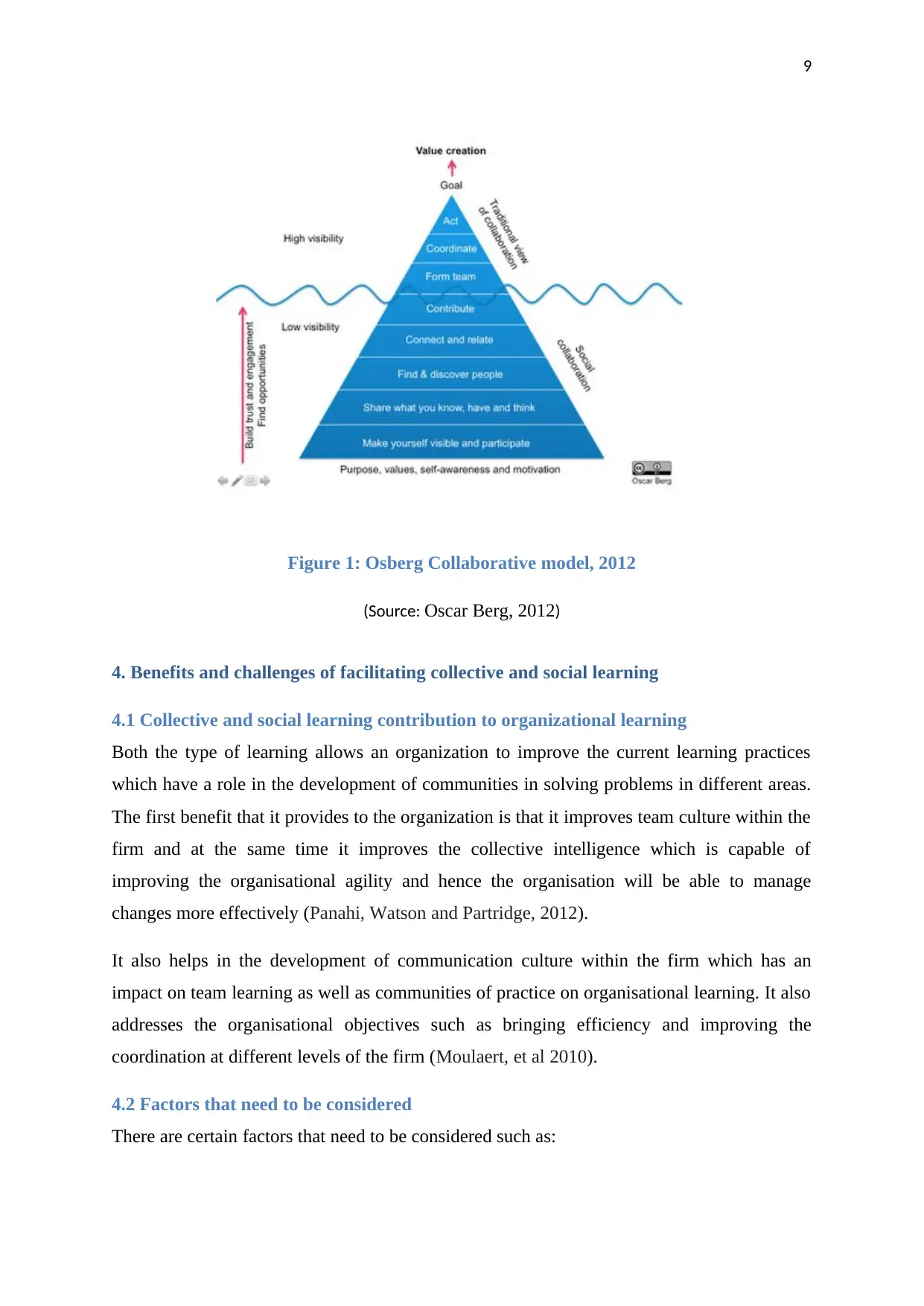
9
Figure 1: Osberg Collaborative model, 2012
(Source: Oscar Berg, 2012)
4. Benefits and challenges of facilitating collective and social learning
4.1 Collective and social learning contribution to organizational learning
Both the type of learning allows an organization to improve the current learning practices
which have a role in the development of communities in solving problems in different areas.
The first benefit that it provides to the organization is that it improves team culture within the
firm and at the same time it improves the collective intelligence which is capable of
improving the organisational agility and hence the organisation will be able to manage
changes more effectively (Panahi, Watson and Partridge, 2012).
It also helps in the development of communication culture within the firm which has an
impact on team learning as well as communities of practice on organisational learning. It also
addresses the organisational objectives such as bringing efficiency and improving the
coordination at different levels of the firm (Moulaert, et al 2010).
4.2 Factors that need to be considered
There are certain factors that need to be considered such as:
Figure 1: Osberg Collaborative model, 2012
(Source: Oscar Berg, 2012)
4. Benefits and challenges of facilitating collective and social learning
4.1 Collective and social learning contribution to organizational learning
Both the type of learning allows an organization to improve the current learning practices
which have a role in the development of communities in solving problems in different areas.
The first benefit that it provides to the organization is that it improves team culture within the
firm and at the same time it improves the collective intelligence which is capable of
improving the organisational agility and hence the organisation will be able to manage
changes more effectively (Panahi, Watson and Partridge, 2012).
It also helps in the development of communication culture within the firm which has an
impact on team learning as well as communities of practice on organisational learning. It also
addresses the organisational objectives such as bringing efficiency and improving the
coordination at different levels of the firm (Moulaert, et al 2010).
4.2 Factors that need to be considered
There are certain factors that need to be considered such as:
Paraphrase This Document
Need a fresh take? Get an instant paraphrase of this document with our AI Paraphraser
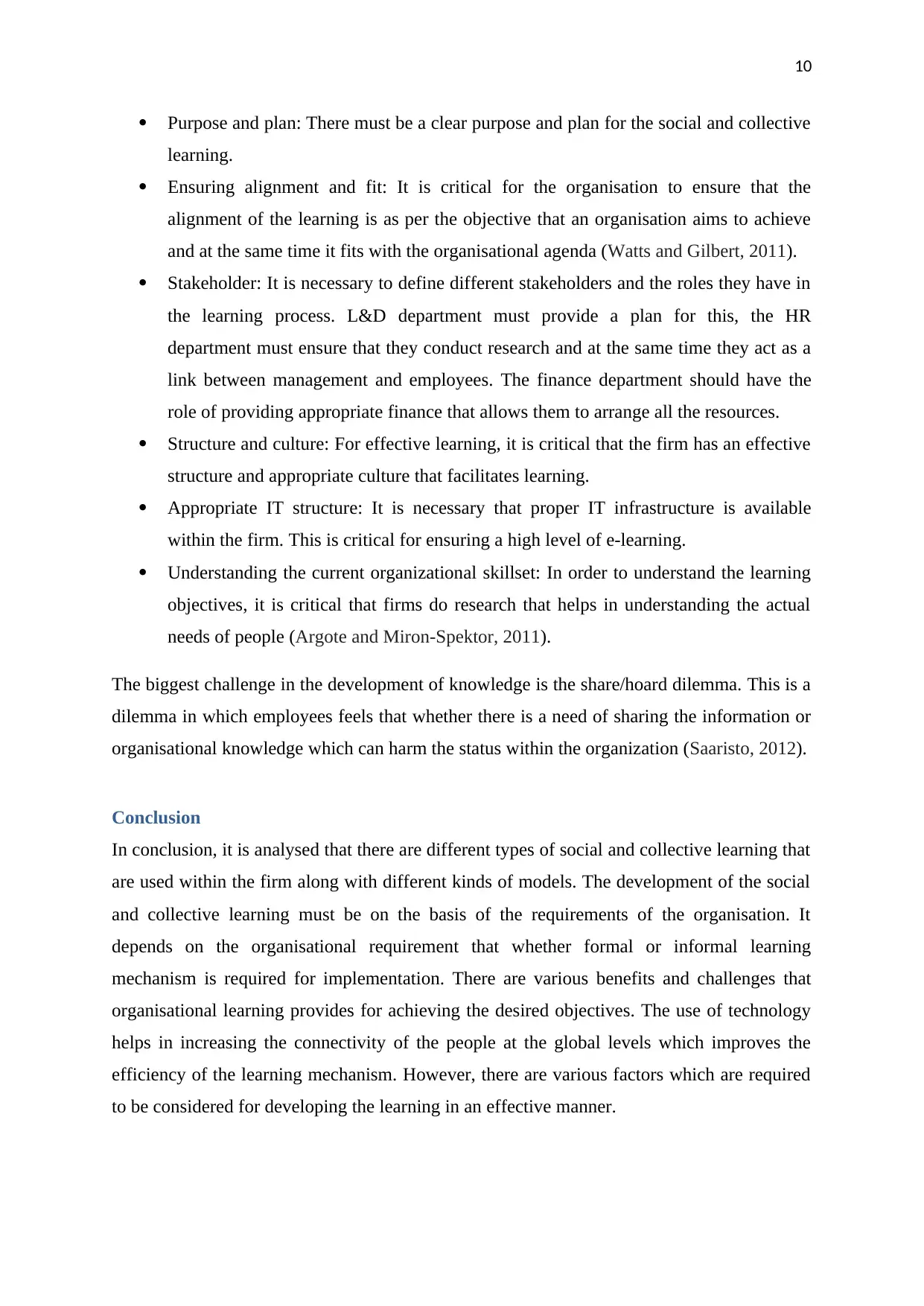
10
Purpose and plan: There must be a clear purpose and plan for the social and collective
learning.
Ensuring alignment and fit: It is critical for the organisation to ensure that the
alignment of the learning is as per the objective that an organisation aims to achieve
and at the same time it fits with the organisational agenda (Watts and Gilbert, 2011).
Stakeholder: It is necessary to define different stakeholders and the roles they have in
the learning process. L&D department must provide a plan for this, the HR
department must ensure that they conduct research and at the same time they act as a
link between management and employees. The finance department should have the
role of providing appropriate finance that allows them to arrange all the resources.
Structure and culture: For effective learning, it is critical that the firm has an effective
structure and appropriate culture that facilitates learning.
Appropriate IT structure: It is necessary that proper IT infrastructure is available
within the firm. This is critical for ensuring a high level of e-learning.
Understanding the current organizational skillset: In order to understand the learning
objectives, it is critical that firms do research that helps in understanding the actual
needs of people (Argote and Miron-Spektor, 2011).
The biggest challenge in the development of knowledge is the share/hoard dilemma. This is a
dilemma in which employees feels that whether there is a need of sharing the information or
organisational knowledge which can harm the status within the organization (Saaristo, 2012).
Conclusion
In conclusion, it is analysed that there are different types of social and collective learning that
are used within the firm along with different kinds of models. The development of the social
and collective learning must be on the basis of the requirements of the organisation. It
depends on the organisational requirement that whether formal or informal learning
mechanism is required for implementation. There are various benefits and challenges that
organisational learning provides for achieving the desired objectives. The use of technology
helps in increasing the connectivity of the people at the global levels which improves the
efficiency of the learning mechanism. However, there are various factors which are required
to be considered for developing the learning in an effective manner.
Purpose and plan: There must be a clear purpose and plan for the social and collective
learning.
Ensuring alignment and fit: It is critical for the organisation to ensure that the
alignment of the learning is as per the objective that an organisation aims to achieve
and at the same time it fits with the organisational agenda (Watts and Gilbert, 2011).
Stakeholder: It is necessary to define different stakeholders and the roles they have in
the learning process. L&D department must provide a plan for this, the HR
department must ensure that they conduct research and at the same time they act as a
link between management and employees. The finance department should have the
role of providing appropriate finance that allows them to arrange all the resources.
Structure and culture: For effective learning, it is critical that the firm has an effective
structure and appropriate culture that facilitates learning.
Appropriate IT structure: It is necessary that proper IT infrastructure is available
within the firm. This is critical for ensuring a high level of e-learning.
Understanding the current organizational skillset: In order to understand the learning
objectives, it is critical that firms do research that helps in understanding the actual
needs of people (Argote and Miron-Spektor, 2011).
The biggest challenge in the development of knowledge is the share/hoard dilemma. This is a
dilemma in which employees feels that whether there is a need of sharing the information or
organisational knowledge which can harm the status within the organization (Saaristo, 2012).
Conclusion
In conclusion, it is analysed that there are different types of social and collective learning that
are used within the firm along with different kinds of models. The development of the social
and collective learning must be on the basis of the requirements of the organisation. It
depends on the organisational requirement that whether formal or informal learning
mechanism is required for implementation. There are various benefits and challenges that
organisational learning provides for achieving the desired objectives. The use of technology
helps in increasing the connectivity of the people at the global levels which improves the
efficiency of the learning mechanism. However, there are various factors which are required
to be considered for developing the learning in an effective manner.

11
References
Agarwal, N., 2011. Collective learning: An integrated use of social media in learning
environment. In Social media tools and platforms in learning environments (pp. 37-51).
Springer, Berlin, Heidelberg.
Argote, L. and Miron-Spektor, E., 2011. Organizational learning: From experience to
knowledge. Organization science, 22(5), pp.1123-1137.
Baker, D., 2015. Collective Learning: a potential unifying theme of human history. Journal of
World History, pp.77-104.
Brown, V.A. and Lambert, J.A., 2012. Collective learning for transformational change: A
guide to collaborative action. Routledge.
Bunderson, J.S. and Reagans, R.E., 2011. Power, status, and learning in
organizations. Organization Science, 22(5), pp.1182-1194.
De Lillo, S. and Bellomo, N., 2011. On the modeling of collective learning
dynamics. Applied mathematics letters, 24(11), pp.1861-1866.
Gholami, B. and Heinzl, A., 2013. Leading agile self-organizing teams: A collective learning
perspective. In OLKC 2013: International Conference on Organizational Learning,
Knowledge and Capabilities.
Gutierrez, K. 2020. The Why’s and How’s of Social Learning in the Workplace. [Online]
Available at: https://www.shiftelearning.com/blog/the-whys-and-hows-of-social-learning-in-
the-workplace. [Accessed on 27th February 2020]
Hager, P. and Johnsson, M.C., 2012. Collective learning practice. In Practice, learning and
change (pp. 249-265). Springer, Dordrecht.
Hoppitt, W. and Laland, K.N., 2013. Social learning: an introduction to mechanisms,
methods, and models. Princeton University Press.
Jones, B.L., 2015. Collective learning resources: Connecting social-learning practices in
deviantART to art education. Studies in Art Education, 56(4), pp.341-354.
Keeble, D. and Wilkinson, F., 2017. High-technology clusters, networking and collective
learning in Europe. Routledge.
References
Agarwal, N., 2011. Collective learning: An integrated use of social media in learning
environment. In Social media tools and platforms in learning environments (pp. 37-51).
Springer, Berlin, Heidelberg.
Argote, L. and Miron-Spektor, E., 2011. Organizational learning: From experience to
knowledge. Organization science, 22(5), pp.1123-1137.
Baker, D., 2015. Collective Learning: a potential unifying theme of human history. Journal of
World History, pp.77-104.
Brown, V.A. and Lambert, J.A., 2012. Collective learning for transformational change: A
guide to collaborative action. Routledge.
Bunderson, J.S. and Reagans, R.E., 2011. Power, status, and learning in
organizations. Organization Science, 22(5), pp.1182-1194.
De Lillo, S. and Bellomo, N., 2011. On the modeling of collective learning
dynamics. Applied mathematics letters, 24(11), pp.1861-1866.
Gholami, B. and Heinzl, A., 2013. Leading agile self-organizing teams: A collective learning
perspective. In OLKC 2013: International Conference on Organizational Learning,
Knowledge and Capabilities.
Gutierrez, K. 2020. The Why’s and How’s of Social Learning in the Workplace. [Online]
Available at: https://www.shiftelearning.com/blog/the-whys-and-hows-of-social-learning-in-
the-workplace. [Accessed on 27th February 2020]
Hager, P. and Johnsson, M.C., 2012. Collective learning practice. In Practice, learning and
change (pp. 249-265). Springer, Dordrecht.
Hoppitt, W. and Laland, K.N., 2013. Social learning: an introduction to mechanisms,
methods, and models. Princeton University Press.
Jones, B.L., 2015. Collective learning resources: Connecting social-learning practices in
deviantART to art education. Studies in Art Education, 56(4), pp.341-354.
Keeble, D. and Wilkinson, F., 2017. High-technology clusters, networking and collective
learning in Europe. Routledge.
⊘ This is a preview!⊘
Do you want full access?
Subscribe today to unlock all pages.

Trusted by 1+ million students worldwide
1 out of 14
Related Documents
Your All-in-One AI-Powered Toolkit for Academic Success.
+13062052269
info@desklib.com
Available 24*7 on WhatsApp / Email
![[object Object]](/_next/static/media/star-bottom.7253800d.svg)
Unlock your academic potential
Copyright © 2020–2025 A2Z Services. All Rights Reserved. Developed and managed by ZUCOL.





